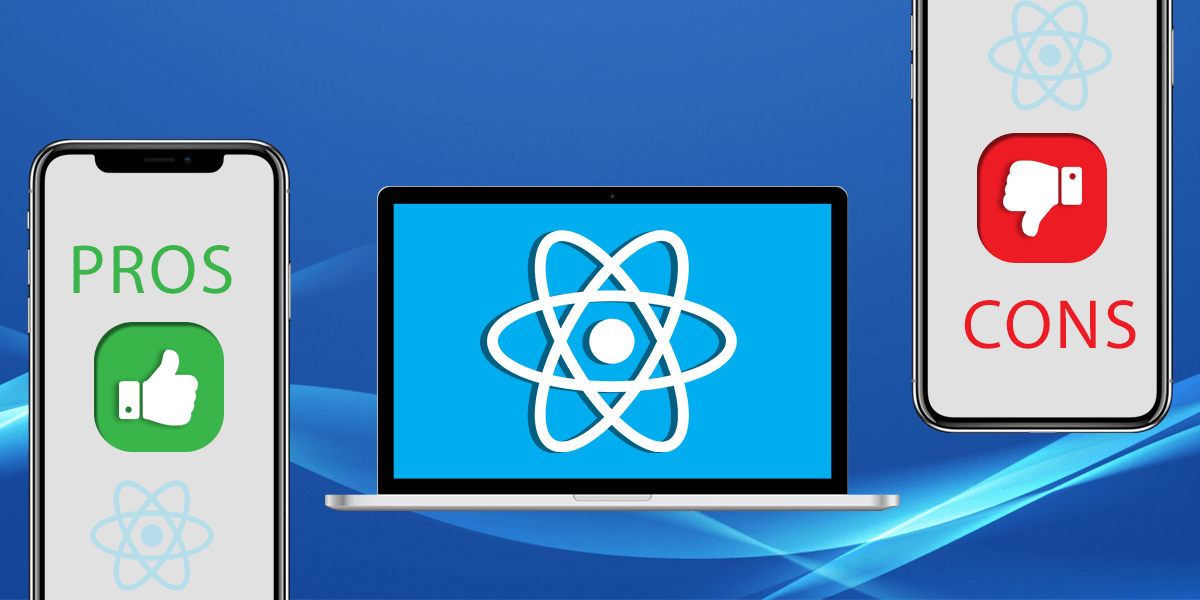The Advantages and Disadvantages of Using React Native as Cross-Platform App Development
- Mobile
- October 24, 2018
The cross-platform app development is seemingly becoming popular as the stratum of competition is exceeding higher up the order.
And beyond any doubt, React Native has been identified as the most preferred cross-platform solution for the creation of both Android and iOS apps respectively. With React Native, you can work on two different Operating Systems using a single platform.
React Native is a Facebook developed open-source framework that lets you create native mobile applications using the JavaScript programming language.
You can develop apps using React Native similar to what you do while employing Java or Kotlin for Android and Objective-C or Swift for iOS.
React Native also proves helpful in building attractive User Interfaces, which cannot be distinguished from a native app.
The React Native may be a popular option, but it isn’t the best choice as it has some drawbacks as well.
Therefore, we would be highlighting the major pros and cons of the React Native, so that you can get an idea when to use the platform and when to avoid it.
The Benefits of React Native

1. Known for Optimal Performance
Undeniably, React Native is a real asset when it comes to improving the performances through native control and modules.
The React Native gets connected to the native components for both the Operating Systems and generates a code to the native APIs upfront and freely.
Now the performance enhances due to the fact that it makes use of a different thread from UI and the native APIs. You can also other alternatives such as opt for the WebView, but it will decline the performance level.
Read also: Steps to Optimizing the Performance of the React Native Applications
2. Can Reuse the Codes and Pre-Developed Components
One of the biggest benefits that you can gain from React Native is the advantage of code reusability. The developers feel blessed and thankful to Facebook as they don’t have to develop a separate mobile app for each platform.
In fact, you integrate 90% of the native framework for reusing the codes for both the OS.
It is because of this unique feature that the developers tend to save a lot of time and also curtail the cost of app development as well.
What’s more pleasing to note that you can also reuse the web application codes for creating a mobile app, if they are written in React.
React Native also accelerates the speed of development due to the presence of the pre-developed components available in the open-source library.
It simply means that the codes are already written in advance and you are just required to implement it according to the app requirements. You are absolutely free to use it.
3. Large Community of Developers
The Fact that React Native is an open-source JavaScript platform where every developer is free to contribute to the framework and it’s easily accessible to all. So, you can take full advantage of the community-driven technology.
This means that if any developer gets stuck somewhere while developing an app, he is free to take the help of the community members who would guide him in this regard.
The support of a large community is also useful as it allows you to share your experiences and portfolios so that you can go for better coding.
There is one platform GitHub React Native Community, which encourages the developers to share their experiences whenever they learning something new about the React Native. They also receive the feedback and reviews on the same establishing better communication with the community members.
Don’t forget that React Native has been introduced by Facebook, the King of Social Media. So, you would also receive extended support from the social media giant.
Indeed, Facebook has created a particular platform to help out the developers initiating the long interactions where you can share your issues and best practices.
4. Advantage of Live and Hot Reloading
The React Native is known for its support for Live and Hot Reloading. Don’t get confused as both are different features.
If we talk about Live Reloading then it’s a tool that helps in compiling and reading the file where the developer had made the changes. It also offers a new file to the stimulator, automatically reading the app from the beginning.
The Hot Reloading is based on the Hot Module Replacement (HMR) and made its inception after the initial reloading process. Although there is not much of a difference in functions and features, but the main aspect comes into play during saving the changes.
The HMR inter-mediator will put the updated files into the specific place even if the app is still running. The key plus point of Hot Reading is that it allows the modification of the source code and as such, you don’t need the app recompilation for viewing the codes.
Thus, if you have a couple of open windows including that of code and the app screen, you would be able to view the outcome instantly after making changes in the code. In fact, Hot Reading also plays a crucial role in reducing the waiting time for changes.
5. React Native is a Cost Effective Solution
We have already discussed in the earlier paragraph how the code reusability in React Native helps to reduce the cost of the app development.
The developers don’t need to use separate codes for both the platforms as both OS can be coded with single programming language.
Now, this makes your project cost more affordable as you don’t have to employ a large team and different developers for getting the job done.
This is another benefit of React Native as a small team size is sufficient to carry out the task. The developers gave in-depth experience and establishing better communication with each others.
6. Offers Simple User Interface
The React Native also offers a simplified mobile User Interface, That is why it is more known as a open-source JavaScript library rather than being a framework.
If you have developed an ideal app, it’s important to get the sequence right, and React Native is just the optimum choice for getting it. It offers a more responsive UI designs and reduces the loading time as well.
7. Support for Third-Party Plugins
The React Native also renders its support for the third-party plugins offering a couple of options that include native modules and JavaScript modules. This is because it does not have some components in the main framework.
For instance, if you are implementing any Map in your app, React Native lets you do so by connecting the plugin with a native or third-party module.
8. Offers More Stable Apps
The React Native offers one of the features or benefits which is simplifying the process of data binding. This is due to this aspect that your apps become more stable and also the level of reliability increases.
The child element does not have any influence on the parent data. The React Native only allows the updating of the permitted components and if you have to make any modification, then you are required to change and apply the updates.
9. Modular Architecture
The Modular Programming helps to segregate the program functions into various different free and interchangeable blocks known as modules.
Now this is software technique that makes the development more flexible and establishes better coordination with each other to get the updates.
React Native is benefited to get this intuitive modular architecture, which helps React Native developers to easily upgrade the apps at quick pace. You can also reuse the modules same as codes for web and mobile APIs.
10. Providing Handy Solutions and Libraries
React Native gives you the advantage of having the best list of ready-made solutions and libraries to simplify the task of mobile app development.
It also has a vast number of libraries that are very useful for the developers. For instance, during the testing library the developers can create error-free codes.
The Cons of React Native
We have discussed why React Native is a popular choice for the developers due to its advantages.
However, without getting prejudiced, we also need to look at the other side of the coin. Yes, now let’s focus on some of its major cons:
1. React Native is Still New and Immature
React Native is newbie as compared to other Android and iOS programming languages,. It is still in its improvement stage and this can have a negative impact on the apps.
- One of the areas where it lacks consistency is regarding the release of the frequent updates, which at times are confusing for the developers. This is because every time a new update is released, the developers have to make a lot of changes and make regular upgrades. Popular app Airbnb faced a lot of problems in the upgrading.
- Secondly, the developers are also sometimes required to write the extra native code for components not compatible with the React Native apart from writing just the codes.
- At times, the React Native components turn poorer in comparison to the native components. It is very difficult to integrate the long and huge list with React Native.
2. Learning the Rope is a Tough Ask
React Native can be a tough rope to learn especially if you are just a fresher in the app development field.
This is due to the presence of JSX in the JavaScript syntax extension where the HTML element gets combined with JavaScript. An average learner won’t find it that easier in comparison to other cross-platform apps.
3. It Lacks the Security Robustness
We know that React Native is a JavaScript library and open-source framework, which creates a gap in the security robustness.
But at times, you need to provide extra security specifically if you are creating banking and financial apps where data is highly confidential. So, in that cases, experts advice not to choose React Native.
4. Takes More Time to Initialize
The problem with React Native is that it takes a lot of time for initializing the runtime even for the hi-tech gadgets and devices before it can be rendered initially.
This is again because of the JavaScript thread which takes time to initialize.
5. Managing the Memory
React Native is not fit to use for the computation of the intensive apps and yet again, the responsibility for this drawback falls on JavaScript.
It becomes difficult to manage the memory and usage because of the float computations that are dealt in a inefficient manner.
Read also: The Difference Between iOS and Android App Development Using React Native
Conclusion
While concluding the discussion on the pros and cons of the React Native we would say that it is a more than useful framework that is known for its cost efficiency and time saving techniques.
It allow developers to reuse the codes and modules and offers the advantage of large community base, hot reloading, and stable apps.
But there are some shortcomings as well and one of the factors that go against it is that it is still new and within the stage of improvement. The developers may find difficulty due to JavaScript toolkit and it is not very powerful from the security point of view.
However, recently, Facebook has changed its licensing policy to MIT License and so there’s a hope that it would get better and better in the future.














